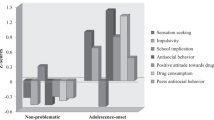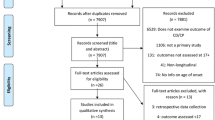Abstract
Understanding youth conduct problems requires examination from a developmental perspective, analyzing distinctive pathways across childhood and adolescence, and identifying early predictors which will lead to specific adolescent outcomes. Bearing this in mind, developmental trajectories of conduct problems were identified from a person-oriented perspective, and using data collected from three waves over a six-year period, in a sample of Spanish children aged 6–11 at the onset of the study. Conduct problems showed five distinctive trajectories which were grouped into three major pathways in further analyses: Stable low, Stable high, and Decreasing. Associations with early personality and psychopathic traits, as well as with a wide range of adolescent behavioral and psychosocial outcomes were examined, revealing the Stable high group as exhibiting the highest risk profile. These results contribute to improving our knowledge about one of the most relevant problems in youth populations, and will help in refining interventions strategies by recognizing the developmental heterogeneity of the construct.

Similar content being viewed by others
References
Thomas CR (2010) Oppositional defiant and conduct disorder. In: Dulcan MK (ed) Dulcan’s textbook of child and adolescent psychiatry. American Psychiatric Publishing, Arlington, pp 223–239
Welsh BC, Loeber R, Stevens BR, Stouthamer-Loeber M, Cohen MA, Farrington DP (2008) Costs of juvenile crime in urban areas: a longitudinal perspective. Youth Violence Juv Justice 6:3–27
Baker K (2013) Conduct disorders in children and adolescents. Paediatr Child Health 23:24–29
Odgers CL, Moffitt TE, Broadbent JM, Dickson N, Hancox RJ, Harrington H, Caspi A (2008) Female and male antisocial trajectories: from childhood origins to adult outcomes. Dev Psychopathol 20:673–716
Trentacosta CJ, Hyde LW, Goodlett BD, Shaw DS (2013) Longitudinal prediction of disruptive behavior disorders in adolescents males from multiple risk domains. Child Psychiatry Hum Dev 44:561–572
Murray J, Farrington DP (2010) Risk factors for conduct disorder and delinquency: key findings from longitudinal studies. Can J Psychiatry 55:633–641
Frick PJ (2012) Developmental pathways to conduct disorder: implications for future directions in research, assessment, and treatment. J Clin Child Adolesc Psychol 41:378–389
Bongers IL, Koot HM, van der Ende J, Verhulst FC (2004) Developmental trajectories of externalizing behaviors in childhood and adolescence. Child Dev 75:1523–1537
Fanti KA, Henrich CC (2010) Trajectories of pure and co-occurring internalizing and externalizing problems from age 2 to age 12: findings from the National Institute of Child Health and Human Development Study of Early Child Care. Dev Psychol 46:1159–1175
Thompson R, Tabone JK, Litrownik AJ, Briggs EC, Hussey JM, English DJ, Dubowitz H (2011) Early adolescent risk behavior outcomes of childhood externalizing behavioral trajectories. J Early Adolesc 31:234–257
Moffitt TE (2006) Life-course persistent versus adolescence-limited antisocial behavior. In: Cicchetti D, Cohen DJ (eds) Developmental psychopathology, 2nd edn, vol 3: risk, disorder and adaptation. Wiley, New York, pp 570–589
Patterson GR (1996) Some characteristics of a developmental theory for early onset delinquency. In: Lenzenweger MF, Haugaard JJ (eds) Frontiers of developmental psychopathology. Oxford University Press, New York, pp 81–124
Shaw DS, Hyde LW, Brennan LM (2012) Early predictors of boys antisocial behavior. Dev Psychopathol 24:871–888
Dandreaux DM, Frick PJ (2009) Developmental pathways to conduct problems: a further test of the childhood and adolescent-onset distinction. J Abnormal Child Psychol 37:375–385
Nagin DS, Tremblay R (1999) Trajectories of boys’ physical aggression, opposition, and hyperactivity on the path to physically violent and nonviolent juvenile delinquency. Child Dev 70:1181–1196
Broidy LM, Nagin DS, Tremblay RE, Bates JE, Brame B, Dodge KA et al (2003) Developmental trajectories of childhood disruptive behaviors and adolescent delinquency: a six-site cross-national study. Dev Psychol 39:222–245
Barker ED, Maughan B (2009) Differentiating early-onset persistent versus childhood-limited conduct problem youth. Am J Psychiat 166:900–908
Shaw DS, Gilliom M, Ingoldsby EM, Nagin S (2003) Trajectories leading to school-age conduct problems. Dev Psychol 39:189–200
Veenstra R, Lindenberg S, Verhulst FC, Ormel J (2009) Childhood-limited versus persistent antisocial behavior: why do some recover and others do not? The TRAILS study. J Early Adolesc 29:718–742
Silver RB, Measelle JR, Armstrong JM, Essex MJ (2005) Trajectories of classroom externalizing behavior: contributions of child characteristics, family characteristics, and the teacher-child relationship during the school transition. J Sch Psychol 43:39–60
Raine A, Moffitt TE, Caspi A, Loeber R, Stouthamer-Loeber M, Lynam DR (2005) Neurocognitive impairments in boys on the life-course persistent antisocial path. J Aborm Psychol 114:38–49
Frick PJ, Viding E (2009) Antisocial behavior from a developmental psychopathology perspective. Dev Psychopathol 21:1111–1131
White SF, Frick PJ (2010) Callous-unemotional traits and their importance to causal models of severe antisocial behavior in youth. In: Salekin RT, Lynam DT (eds) Handbook of child and adolescent psychopathy. Guilford, New York, pp 135–155
López-Romero L, Romero E, Luengo MA (2012) Disentangling the role of psychopathic traits and externalizing behavior in predicting conduct problems from childhood to adolescence. J Youth Adolescence 41:1397–1408
Marshall LE, Marshall WL (2011) Empathy and antisocial behavior. J Forens Psychiatry Psychol 22:742–759
Campbell SB, Spieker S, Burchinal M, Poe MD (2006) Trajectories of aggression from toddlerhood to age 9 predict academic and social functioning through age 12. J Child Psychol Psychiatr 47:791–800
Achenbach TM (1991) Manual for the child behavior checklist and 1991 profile. University of Vermont, Burlington
Lynam DR (1997) Pursuing the psychopath: capturing the fledgling psychopath in a nomological net. J Aborm Psychol 106:425–438
Verschuere B, Candel I, Van Reenen LV, Korebrits A (2012) Validity of the Modified Child Psychopathy Scale for juvenile justice center residents. J Psychopathol Behav 34:244–252
Silva F, Martorell C, Clemente A (1986) Socialization and personality: study through questionnaires in a preadult Spanish population. Pers Indiv Dif 7:355–372
Del Barrio MV, Aluja A, García L (2004) Bryant’s Empathy Index for children and adolescents: psychometric properties in Spanish language. Psychol Rep 95:257–262
Frick PJ (2004) Inventory of callous-unemotional traits. Unpublished rating scale, University of New Orleans, New Orleans, LA
Conners CK (1997) Conners rating scales-revised. Multi-Health System, Toronto
Dodge KA, Coie JD (1987) Social information processing factors in reactive and proactive aggression in children’s peer groups. J Pers Soc Psychol 53:1146–1158
Conduct Problems Prevention Research Group (1995) Social Competence Scale (Parent Version). Pennsylvania State University, University Park
López-Romero L, Romero E, Gómez-Fraguela JA (2014) Delving into callous-unemotional traits in a Spanish sample of adolescents: concurrent correlates and early parenting precursors. J Child Fam Stud. doi:10.1007/s10826-014-9951-2
Muthén LK, Muthén BO (1998–2011). Mplus user’s guide, 6th ed. Muthén & Muthén, Los Ángeles
Nylund KL, Asparouhov T, Muthén B (2007) Deciding on the number of classes in latent class analysis and growth mixture modeling: a Monte Carlos simulation study. Struct Equ Model 14:535–569
Nagin D (2005) Group-based modeling of development. Harvard University Press, Cambridge
Reef J, Diamantopoulou S, van Meurs I, Verhulst FC, van der Ende J (2011) Developmental trajectories of child to adolescent externalizing behavior and adult DSM-IV disorder: results of a 24-year longitudinal study. Soc Psychiatry Psychiatr Epidemiol 46:1233–1241
Vaughn MG, DeLisi M, Gunter T, Fu Q, Beaver KM, Perron BE et al (2011) The severe 5%: a latent class analysis of the externalizing behavior spectrum in the United States. J Crim Just 39:75–80
Miner JL, Clarke-Stewart KA (2008) Trajectories of externalizing behavior from age 2 to age 9: relations with gender, temperament, ethnicity, parenting, and rater. Dev Psychol 44:771–786
Frick PJ, Ray JV, Thornton LC, Kahn RE (2014) Can callous-unemotional traits enhance the understanding, diagnosis, and treatment of serious conduct problems in children and adolescents? A comprehensive review. Psychol Bull 40:1–57
Frick PJ, Barry CT, Kamphaus RW (2010) Clinical assessment of child and adolescent personality and behavior. Springer, New York
Acknowledgments
This research was supported by the Spanish Ministries of Health (National Plan on Drugs), and Education (Grant BS02003-10340, and the Teacher Training University Program—Programa de Formación de Profesorado Universitario, FPU: AP2009-0714).
Author information
Authors and Affiliations
Corresponding author
Rights and permissions
About this article
Cite this article
López-Romero, L., Romero, E. & Andershed, H. Conduct Problems in Childhood and Adolescence: Developmental Trajectories, Predictors and Outcomes in a Six-Year Follow Up. Child Psychiatry Hum Dev 46, 762–773 (2015). https://doi.org/10.1007/s10578-014-0518-7
Published:
Issue Date:
DOI: https://doi.org/10.1007/s10578-014-0518-7




